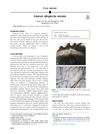TLDR The woman's hair loss might be due to a chronic infection.
A 30-year-old woman presented with diffuse alopecia, characterized by generalized thinning of hair across the scalp without scaling or keratosis pilaris. Tests for fungi and the Wassermann reaction were negative. Treatment involved a mild sulfur and salicylic acid ointment. Dr. Samuel Ayres Jr. suggested the condition might be a type of toxic alopecia, potentially linked to a chronic infection, although the patient did not report a preceding fever. He noted similar cases of diffuse alopecia and alopecia areata following acute infections, referencing observations from the 1918 influenza epidemic.
 148 citations
,
December 2018 in “Journal of autoimmunity”
148 citations
,
December 2018 in “Journal of autoimmunity” Alopecia areata is an autoimmune disease causing patchy hair loss, often with other autoimmune disorders, but its exact causes are unknown.
 4 citations
,
November 2018 in “JAAD case reports”
4 citations
,
November 2018 in “JAAD case reports” Alopecia areata can sometimes appear as a straight line of hair loss instead of round patches.
May 2018 in “Journal of cosmetology & trichology” Combining platelet-rich plasma therapy with prostaglandin-F eye drops can significantly regrow hair in alopecia universalis.
110 citations
,
December 2013 in “The journal of investigative dermatology. Symposium proceedings/The Journal of investigative dermatology symposium proceedings” Alopecia areata is a genetic and immune-related hair loss condition that is often associated with other autoimmune diseases and does not typically cause permanent damage to hair follicles.

